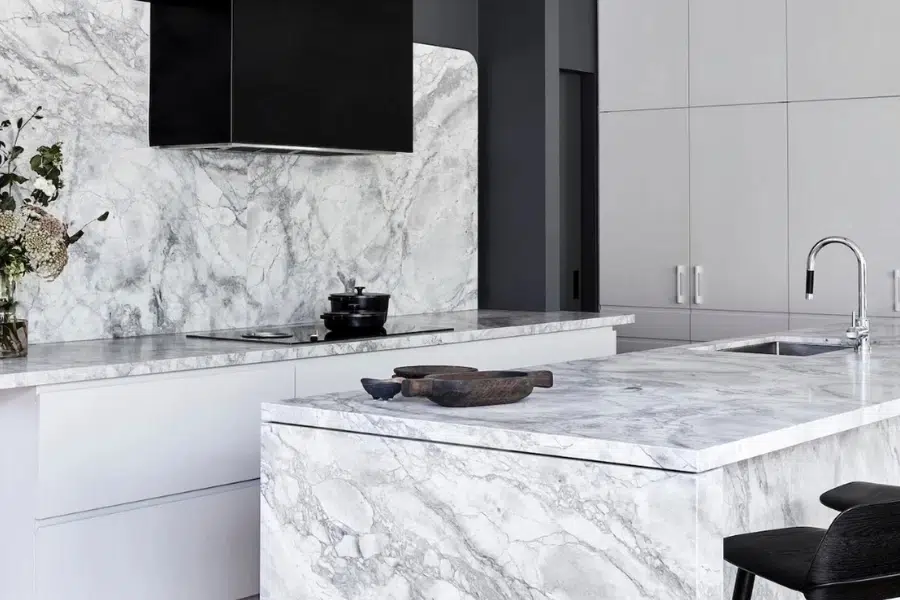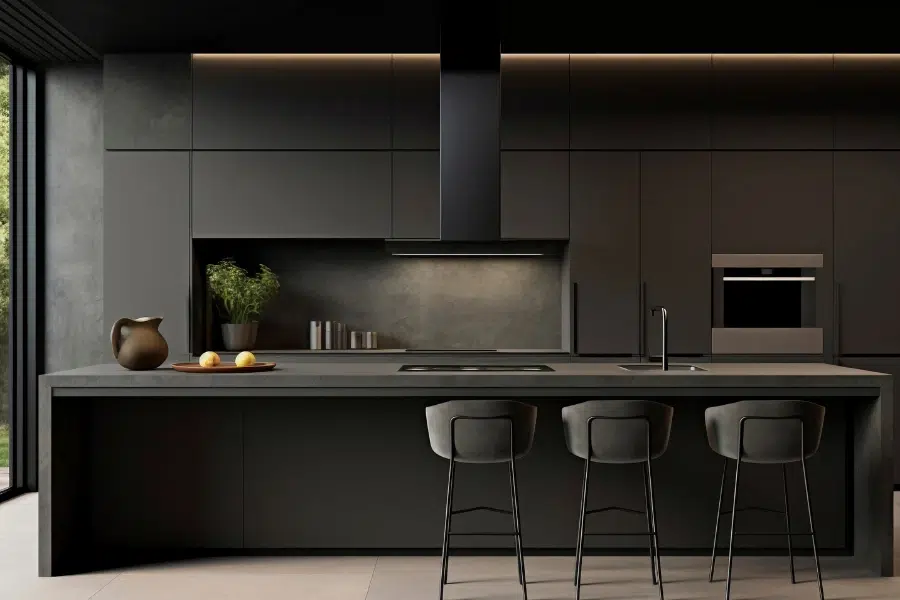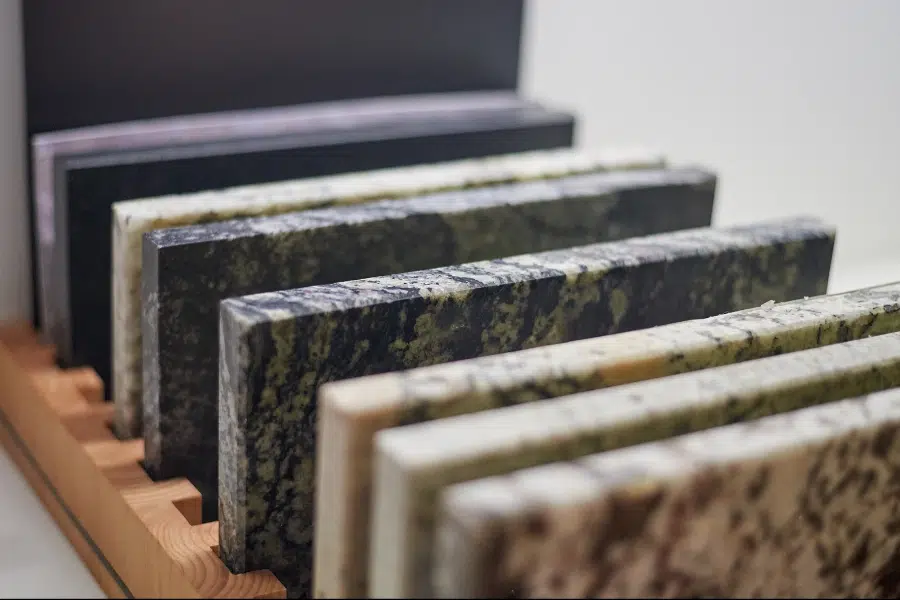The material composition and manufacturing processes of both sintered stone and engineered stone slabs explain much about their properties and uses. Understanding these can help in making an informed decision on which material is best for a project.
Sintered stone is created from a mix of natural minerals that are subjected to extremely high temperatures and pressured together. In forming sintered stone, this process is like that through which natural stone is formed. This would, in turn, yield a stone with a very hard surface that is non-porous, UV-resistant, and can bear extreme weather conditions, making it useful both indoors and outdoors. Sintered stone is associated with a timeless appearance, and varied finishes, making it resemble natural stone in so many ways.
On the other hand, the engineered stone slabs constitutes around 90–95% crushed natural quartz. The rest of the material is made up of 5–10% resin binders and pigments. There is a very high percentage of quartz in the material; it has the characteristic feature of high hardness, giving it resistance to scratching and impact. Resin binders enhance the flexibility and general toughness of the material. Engineered stone’s flexibility and durability make it very popular in countertops, flooring, and cladding. It shows natural beauty with contemporary characteristics.
Sintered stone slabs are known to possess excellent durability. These slabs are scratch, stain, and heat resistant, making them perfect for high-traffic areas and outdoors. The non-porous nature of the sintered stone, besides leading to more durability, does not support bacteria and mould growth. This feature provides a clean and hygienic surface that requires less maintenance, thus making the sintered stone suitable for both residential and commercial purposes.
The visual appeal and design flexibility of sintered stone slabs and engineered stone are significant factors in their popularity. Both materials offer unique aesthetics that cater to various design requirements. One of the strong points in the application of both sintered stone and engineered stone slabs is their aesthetic versatility.
Sintered stone can replicate the appearance of other natural materials, such as marble and granite. It is available in a variety of colors and patterns, often featuring realistic veining and textures. Many sintered stone products feature through-body designs, meaning the pattern runs all the way through the slab to give it a more realistic appearance and hide chips and scratches.
Engineered stone comes in very diverse colors and designs. The manufacturing process involves the use of pigmentation, which does allow for consistent coloring and creates complex patterns that can be made to mimic natural stone or create a unique look in many modern designs. Most engineered stone slabs has only a top-layer design, with the pattern printed on the surface, which is less deep compared to sintered stone but allows a high degree of control over the final appearance.
Cost is one of the principal factors in choosing materials for your work. The prices of sintered stone and engineered stone reflect the different ways of production and inherent qualities. Knowing how they differ in cost will let you make a better decision based on your budget and the demands of your projects.
Sintered stone tends to be at the higher end of the price spectrum. This is mainly due to the advanced manufacturing process. Sintered stone slabs may require a relatively higher initial investment, but their long service life and low maintenance could provide the lowest life-cycle cost for long-lived applications. This makes this stone worth considering for someone who wants long-lasting value combined with high performance for any of their projects.
While engineered stone slabs is more affordable than sintered stone and represents much better value regarding its durability and attractive appearance, it still has a blend of strength and design flexibility due to its constituent materials: natural quartz and resin binders. Its price may differ significantly depending on many factors, like a brand or design or slab thickness, but it is always positioned as one of the more budget-friendly options. When looking for a cheaper alternative with the same basic attributes of durability and appearance, an engineered stone slabs slabs becomes very useful.
Sintered stone is very easy to maintain, hence proper in those areas where hygiene is important. Cleaning sintered stone slabs involves just a simple wipe with mild soap and water. The non-porous surface is naturally resistant to discoloration and does not require any periodic sealing. This easy maintenance routine is responsible for keeping sintered stone looking new. It is especially for these reasons that the low maintenance required of sintered stone slabs makes them perfect for kitchen countertops, bathroom vanity tops, and flooring in high-traffic areas.
Engineered stone also has very minimal maintenance requirements, making it versatile and practical. This should be cleaned with non-abrasive cleaners to keep its appearance and functionality; this is so as not to ruin the resin surface on the top. Using cutting boards and trivets will also secure the surface from scratches and heat damage, though the engineered stone is less porous than natural stone. These simple care practices can help extend the life of your engineered stone slabs surface, giving you beauty and function for years to come. And it’s durable and beautiful, so engineered stone slabs remains the top choice for kitchens, baths, and other hard-wear areas.
Knowing the uses and applications of sintered stone slabs and engineered stone will help people to know which material best fits their needs. Both materials provide versatile solutions for different environments.
Sintered stone slabs have high hardness and non-porous nature make them perfect for both indoor and outdoor uses. This type of stone works perfectly as flooring in high-traffic areas of a house, including hallways and living rooms, but also resists the wear of commercial spaces. Besides, it has UV resistance and weather resistance; thus, it is a great outdoor solution for outdoor kitchens, patios, and building façades.
The low porosity of engineered stone allows it to work in bathrooms for every type of application, from countertops to shower surrounds and backsplashes, so that a long-lasting, hygienic surface is achieved. Engineered stone also works as effective flooring in residential and commercial applications. It is also suitable for decorative wall cladding, where its aesthetic versatility and low maintenance requirements can add a very modern touch to interior designs.




